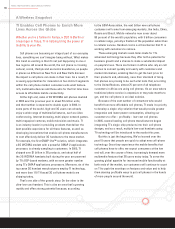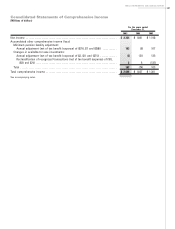Texas Instruments 2005 Annual Report Download - page 14
Download and view the complete annual report
Please find page 14 of the 2005 Texas Instruments annual report below. You can navigate through the pages in the report by either clicking on the pages listed below, or by using the keyword search tool below to find specific information within the annual report.
Gains and losses from other forward currency exchange contracts intended to hedge specific transactions and
from terminated forward currency exchange contracts are deferred and included in the measurement of the
related transactions.
With respect to long-term debt and its associated interest expense, we seek to maintain a mix of both fixed and variable
interest rates that, over time, is expected to moderate financing costs. In order to achieve this goal, we utilize interest
rate swaps designated as fair value hedges to change the characteristics of the interest rate stream on the debt from
fixed rates to short-term variable rates. Gains and losses from interest rate swaps are included on the accrual basis in
interest expense. There is no hedge ineffectiveness related to these swaps. Gains and losses from terminated interest
rate swaps are deferred and recognized consistent with the terms of the underlying transaction.
We do not use derivatives for speculative or trading purposes.
Revenue Recognition: Revenue from sales of our products, including shipping fees, is recognized when title to the
products is transferred to the customer, which usually occurs upon shipment or delivery, depending upon the terms of
the sales order. Estimates of returns for product quality reasons and of price allowances (calculated based upon
historical experience, analysis of product shipments and contractual arrangements with customers), are recorded when
revenue is recognized. Allowances include discounts for prompt payment, as well as volume-based incentives and
special pricing arrangements. In addition, allowances for doubtful accounts are recorded for estimated amounts of
accounts receivable that may not be collected.
Revenue from sales to distributors of our products is recognized, net of allowances, upon delivery of product to the
distributors. These allowances are calculated based on historical data, current economic conditions and contractual
terms. For instance, when we determine that a product may become obsolete, we offer distributors an opportunity to
return that product within a set time period of the obsolescence notification. We also provide distributors the opportunity
to scrap certain designated products based on a limited allowance, which we increased in 2005 to offset reductions in
return privileges. In addition, in response to specific competitive situations encountered by distributors, we may grant
distributors adjustments applied to their account; however, pricing to the distributor is not changed.
Royalty revenue is recognized upon sale by the licensee of royalty-bearing products, as estimated by us, and when
realization is considered probable by management.
Shipping and handling costs are included in cost of revenue.
Advertising Costs: Advertising and other promotional costs are expensed as incurred. This expense was $126 million in
2005, $92 million in 2004 and $79 million in 2003.
Impairments of Long-Lived Assets: Reviews are regularly performed to determine whether facts or circumstances exist
that indicate the carrying values of fixed assets, intangible assets or capitalized software licenses are impaired. We
assess the recoverability of assets by comparing the projected undiscounted net cash flows associated with those assets
to their respective carrying amounts. Impairment, if any, is based on the excess of the carrying amount over the fair
value of those assets. Fair value is determined by available market valuations, if applicable, or by discounted cash flows.
Income Taxes: We account for income taxes using an asset and liability approach. We record the amount of taxes
payable or refundable for the current year and the deferred tax assets and liabilities for the future tax consequences of
events that have been recognized in the financial statements or tax returns. When it is more likely than not that some
portion or all of the deferred tax assets will not be realized, a valuation allowance is recorded.
12
TEXAS INSTRUMENTS 2005 ANNUAL REPORT
























